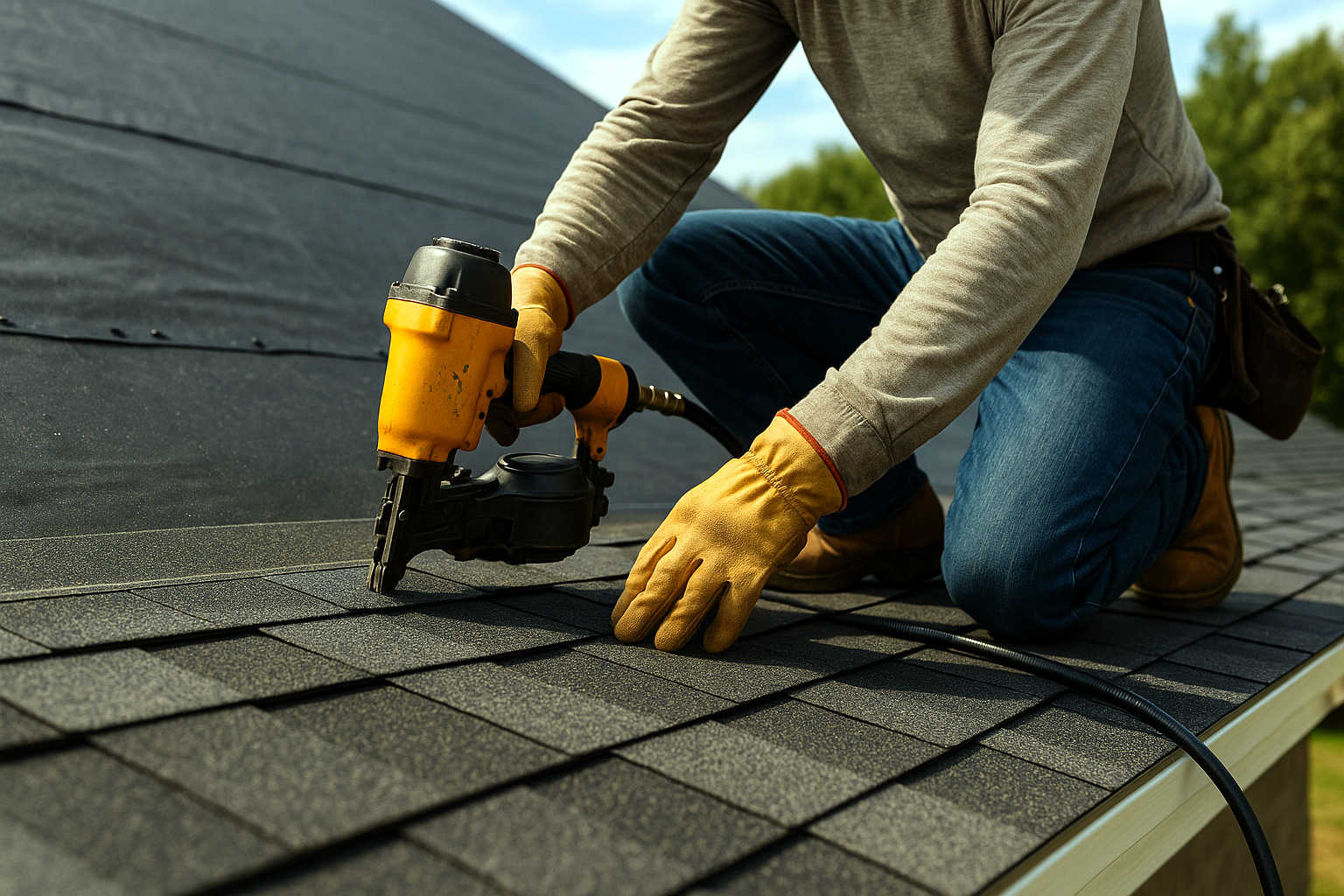The Role of Roofing Underlayment What’s Under the Shingles Matters

When most people think about a roof, shingles are the first thing that comes to mind. They see colors, styles, and patterns, but what’s hidden beneath is as important—if not more so. Roofing underlayment acts as an unseen shield. It protects your home from water, wind, and weather damage. Without it, shingles alone could never withstand the forces of nature. Imagine living in Amarillo with blistering summers, sudden hailstorms, or winter ice dams. Shingles may look strong, but they aren’t waterproof.
That’s where roofing underlayment steps in to provide the shield that saves your home from costly damage. Tascosa Roofing LLC understands this better than anyone. Homeowners understand that what’s beneath the shingles is important. With the right roofing underlayment, they get lasting protection, comfort, and peace of mind. This silent guardian is the foundation of every durable roof.
Roofing underlayment is not an accessory—it’s an essential part of every roof installation. It acts as a barrier between the roof deck and shingles. This provides strong protection against water, heavy winds, and harsh UV rays. When choosing roofing underlayment, you have options: synthetic, asphalt-saturated felt, or rubberized asphalt. Each type is important for protecting your home. Breathable roof underlayment membranes and self-adhered (peel-and-stick) options boost roof strength and efficiency.
At Tascosa Roofing LLC, the team helps homeowners choose the right materials. This includes underlayment for asphalt shingles or high-temp underlayment for metal roofs. With decades of experience, they understand how to balance cost, performance, and durability. Hidden as it may be, roofing underlayment is the detail that separates an average roof from one that lasts for generations.
Key Considerations for Roofing Underlayment
- Proper Installation Ensures Long-Term Protection
- Different Types Serve Different Needs
- Synthetic Roofing Underlayment Offers Superior Durability
- Asphalt-Saturated Felt Underlayment Remains a Classic Option
- Rubberized Asphalt Underlayment Provides Extra Waterproofing
- Self-Adhered Roof Underlayment Protects Against Ice Dams
- Ice and Water Shield Adds Critical Defense
- Roof Deck Protection Prevents Costly Repairs
- Breathable Membranes Allow Moisture to Escape
- Non-Bitumen Synthetic Underlayment Improves Longevity
- High-Temperature Underlayment Works for Metal Roofs
- UV-Resistant Roofing Underlayment Withstands Sun Exposure
- Slip-Resistant Materials Make Installation Safer
- High Tear-Strength Underlayment Resists Harsh Conditions
- Waterproof Membranes Guard Against Leaks
- Specialized Underlayment for Asphalt Shingles Extends Life
- Metal Roof Underlayment Handles Thermal Expansion
- Comparing #15 vs. #30 Felt for Performance
- Polypropylene Underlayment Adds Value and Protection
- Nail Sealability Prevents Leaks Around Fasteners
Proper Installation Ensures Long-Term Protection
A roofing underlayment is only as effective as its installation. Even the best materials will fail when they are not applied in the correct manner. Tascosa Roofing LLC specializes in precise installation. They ensure that underlayment overlaps are tight, seal fasteners, and secure moisture barriers. This meticulous work guarantees long-term protection for your home.
Different Types Serve Different Needs
Not all homes and climates need the same roofing underlayment. Choices include synthetic roofing underlayment, asphalt-saturated felt, and rubberized asphalt. Each provides unique strengths. Tascosa Roofing LLC helps homeowners consider durability, budget, and weather. This way, they can choose the best roofing type.
Synthetic Roofing Underlayment Offers Superior Durability
Synthetic roofing underlayment is lightweight, tear-resistant, and resistant to UV damage. It offers superior strength compared to traditional felt. Many homeowners choose this option for its longevity, especially in windy climates. Tascosa Roofing LLC installs synthetic roofing underlayment for long-lasting performance.
Asphalt-Saturated Felt Underlayment Remains a Classic Option
Contractors have used asphalt-saturated felt underlayment, often called “felt paper,” for decades. It may not last as long as synthetic options, but it remains a reliable and affordable choice. Tascosa Roofing LLC uses asphalt-saturated felt when homeowners want a proven, cost-effective underlayment.
Rubberized Asphalt Underlayment Provides Extra Waterproofing
Rubberized asphalt underlayment is self-sealing and offers high resistance to water penetration. Roofers often use it in vulnerable roof areas such as valleys and eaves. Tascosa Roofing LLC suggests rubberized asphalt underlayment. It’s ideal for roof spots that often have issues.
Self-Adhered Roof Underlayment Protects Against Ice Dams
Self-adhered (peel-and-stick) roof underlayment creates a watertight bond to the roof deck. This option is excellent for ice and water shield protection in regions where ice dams are a concern. Tascosa Roofing LLC often uses peel-and-stick underlayment in colder climates or shaded roof areas.
Ice and Water Shield Adds Critical Defense
Ice and water shield underlayment protects against leaks caused by ice dams and wind-driven rain. It’s a vital component for roof decks in areas with winter weather. Tascosa Roofing LLC suggests using ice and water shield protection. Apply it around edges, valleys, and areas with penetrations, such as chimneys.
Roof Deck Protection Prevents Costly Repairs
Without proper roof deck protection, moisture seeps into wood decking, leading to rot. Roofing underlayment acts as the first line of defense. Tascosa Roofing LLC emphasizes deck protection as one of the most important steps in extending the life of your roof.
Breathable Membranes Allow Moisture to Escape
A breathable roof underlayment lets moisture out of the attic but keeps water out. This balance reduces mold growth and structural damage. Tascosa Roofing LLC installs breathable membranes. These help homeowners get better ventilation and save energy.
Non-Bitumen Synthetic Underlayment Improves Longevity
Non-bitumen synthetic underlayment provides extra strength, tear resistance, and longer exposure times. It’s a premium choice for homeowners who want the greatest protection. Tascosa Roofing LLC installs these products on homes requiring extended durability.
High-Temperature Underlayment Works for Metal Roofs
Metal roofs need special high-temperature underlayment. This material withstands extreme heat without breaking down. Tascosa Roofing LLC installs high-temperature roofing underlayment under metal panels. This helps manage thermal expansion and contraction.
UV-Resistant Roofing Underlayment Withstands Sun Exposure
UV-resistant roofing underlayment can remain exposed longer during construction without degrading. This feature provides flexibility during installation projects. Tascosa Roofing LLC uses UV-resistant underlayment when project timelines need added resilience.
Slip-Resistant Materials Make Installation Safer
Many synthetic roofing underlayments are slip-resistant, making them safer for workers. A walkable surface prevents accidents and speeds up installation. Tascosa Roofing LLC values safety and selects slip-resistant products whenever possible.
High Tear-Strength Underlayment Resists Harsh Conditions
Wind and weather can put intense strain on a roof. High tear strength underlayment resists ripping and keeps the roof secure. Tascosa Roofing LLC installs strong roofing underlayment in places hit by heavy storms.
Waterproof Membranes Guard Against Leaks
Waterproof roofing membranes stop leaks before they start. They seal against rain and snow, ensuring the roof deck stays dry. Tascosa Roofing LLC installs waterproof membranes for the best homeowner protection.
Specialized Underlayment for Asphalt Shingles Extends Life
Underlayment for asphalt shingles reduces wear and increases roof longevity. By adding a protective barrier, it extends the life of the shingles. Tascosa Roofing LLC uses high-quality shingle underlayment to maximize roof value.
Metal Roof Underlayment Handles Thermal Expansion
Metal roof underlayment must tolerate expansion and contraction. Special materials prevent cracking under intense heat. Tascosa Roofing LLC ensures proper underlayment installation for every metal roof system.
Comparing #15 vs. #30 Felt for Performance
Felt underlayment comes in different weights, including #15 and #30. The heavier #30 felt is stronger and more resistant to tearing. Tascosa Roofing LLC helps homeowners decide which option fits their budget and needs.
Polypropylene Underlayment Adds Value and Protection
Polypropylene or polyolefin underlayment is lightweight, durable, and cost-effective. It’s gaining popularity among homeowners who want modern solutions. Tascosa Roofing LLC recommends polypropylene underlayment. It offers a good mix of affordability and performance.
Nail Sealability Prevents Leaks Around Fasteners
A key feature of advanced underlayment is nail sealability—the ability to seal around fasteners and block leaks. Tascosa Roofing LLC installs underlayment with excellent sealability to ensure homes remain watertight.
FAQs
1. What Is Roofing Underlayment?
Roofing underlayment is a protective layer installed between the roof deck and shingles. It provides waterproofing and acts as a secondary defense against leaks.
2. Why Is Roofing Underlayment Necessary?
It prevents water, ice, and wind from damaging the roof deck and structure. Without it, shingles alone cannot protect your home.
3. What Types of Roofing Underlayment Are Available?
The main types include synthetic roofing underlayment, asphalt-saturated felt, and rubberized asphalt underlayment.
4. How Long Does Roofing Underlayment Last?
High-quality underlayment can last 20–30 years, depending on the material and installation.
5. What Is Ice And Water Shield?
It’s a self-adhering underlayment designed to prevent leaks from ice dams and wind-driven rain.
6. Which Roofing Underlayment Is Best for Metal Roofs?
High-temperature underlayment is best for metal roofs, as it withstands heat and thermal expansion.
7. Can Roofing Underlayment Be Left Exposed?
Some UV-resistant underlayments can stay exposed for weeks or months during construction. But it’s better to install shingles without delay.
8. What is the Difference Between #15 and #30 Felt?
#30 felt is thicker and stronger, offering better resistance to tearing than #15 felt.
9. How Does Synthetic Roofing Underlayment Compare to Felt?
Synthetic is more durable, lighter, and longer-lasting than traditional felt underlayment.
10. Does Roofing Underlayment Help With Energy Efficiency?
Yes. Breathable membranes allow moisture to escape while improving insulation and reducing mold risk.
Protecting Your Roof from the Inside Out
Roofing underlayment may not be visible, but it plays a powerful role in roof performance. It shields your home from leaks, supports shingles, and adds decades to your roof’s life. From synthetic options to ice and water shields, the right choice makes all the difference. Tascosa Roofing LLC helps homeowners get the right products and expert installation.
Trust Tascosa Roofing LLC With Your Roof
Your roof deserves more than shingles—it needs a strong foundation. Tascosa Roofing LLC offers expert installation of roofing underlayment for homes in Amarillo. Call 806-454-9277, send an email, or fill out the web form today. Protect your home with the company that knows what’s under the shingles that matter most.
Tascosa Roofing
806-454-9277
Send an email.
Fill out our Web Form
